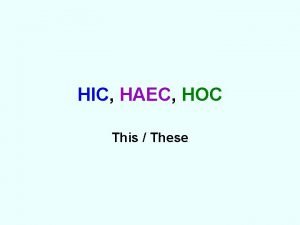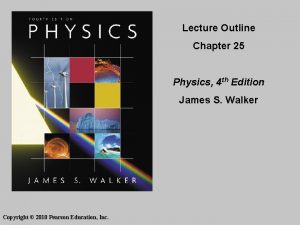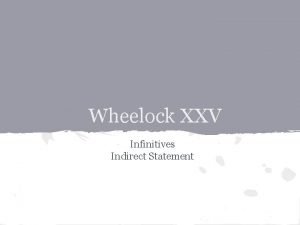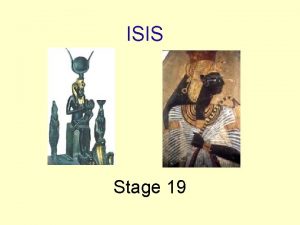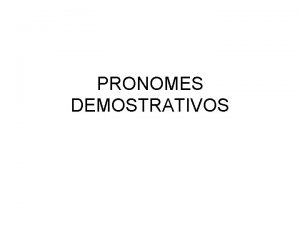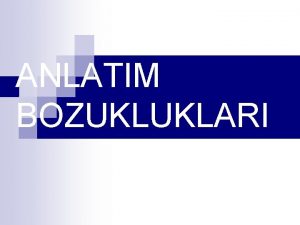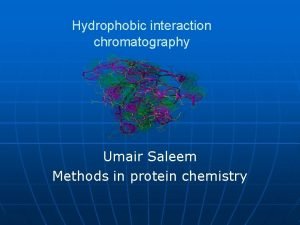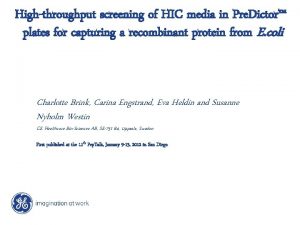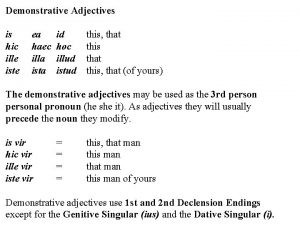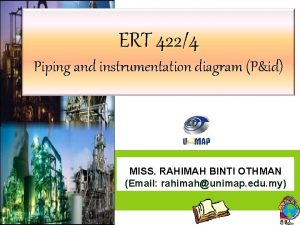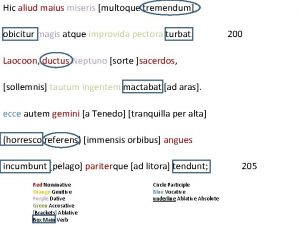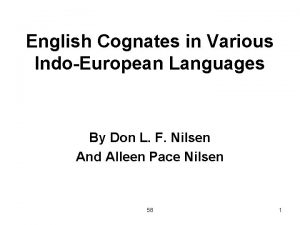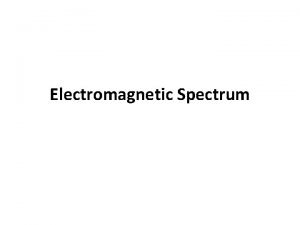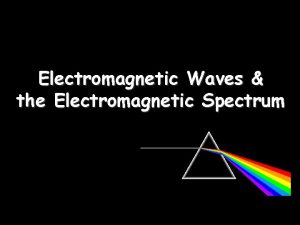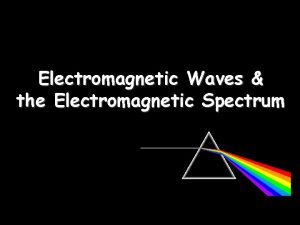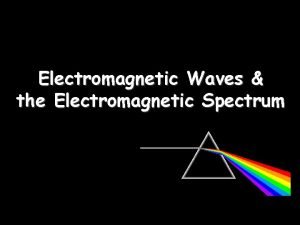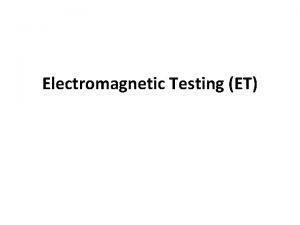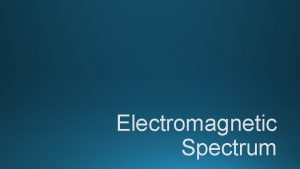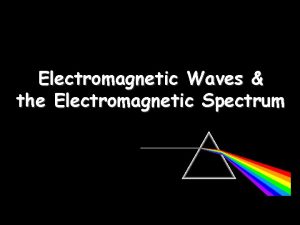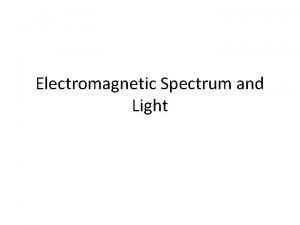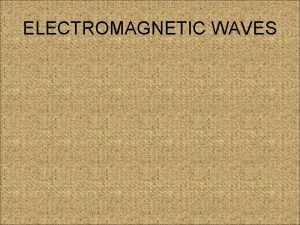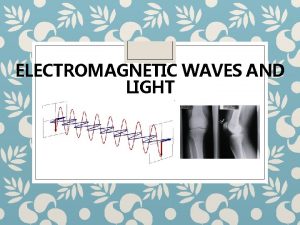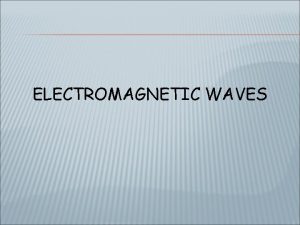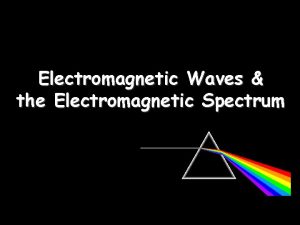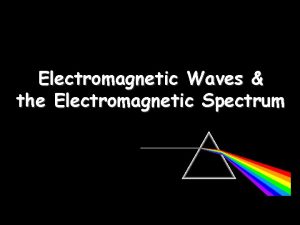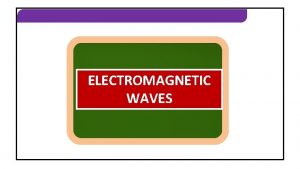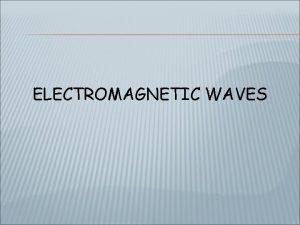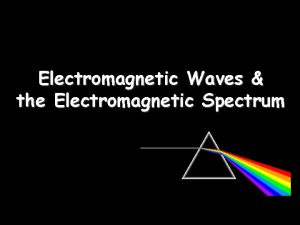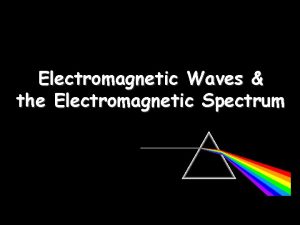Lecture 2 Evolution of electromagnetic field in HIC



































- Slides: 35

Lecture 2. Evolution of electromagnetic field in HIC and the Chiral Magnetic Effect ♥ Introductory remarks (what is the CME ? ) ♥ Electromagnetic field created by HIC (Phys. Rev. C 84, 035202 (2011)) ♥ Analysis of CME experiments (Phys. Rev. C 85, 034910 (2012), ar. Xiv: 1208. 2518) ♥ Conclusions

Hot quark soup produced at RHIC

Parity violation in strong interactions In QCD, chiral symmetry breaking is due to a non-trivial topological effect; among the best evidence of this physics would be event-by-event strong parity violation. The volume of the box is 2. 4 by 3. 6 fm. The topological charge density of 4 D gluon field configurations. (Lattice-based animation by Derek Leinweber) Energy of gluonic field is periodic in NCS direction (~ a generalized coordinate) NC S = 2 -1 0 Dynamics is a random walk between states with different topological charges. 1 2 Instantons and sphalerons are localized (in space and time) solutions describing transitions between different vacua via tunneling or go-over-barrier In the vicinity of the deconfinement phase transition QCD vacuum can posses metastable domain leading to P and PC violation

Topological charge fluctuations in gluodynamical vacuum Buividovich, Kalaijan, Polikarpov

Chiral magnetic effect These transitions with changing the topological charge involve configurations which may violate P and CP invariance of strong interactions. Fermions can interact with a gauge field configurations, transforming left- into right-handed quarks and vice-versa via the axial anomaly and thus resulting in generated asymmetry between left - and right-handed fermions. In this states a balance between lefthanded and right-handed quarks is destroyed, NL-NR=2 NFQw → violation of P-, CP- symmetry. Dynamics is a random walk between states with different topological charges. Average total topological charge vanishes <nw>=0 but variance is equal to the total number of transitions <nw 2>=Nt In the presence of inbalanced chirality a magnetic field induces a current along the magnetic field.

Chiral magnetic effect D. Kharzeev, PL B 633, 260 (2006); D. Kharzeev. A. Zhitnitsky, NP A 797, 67 (2007); D. Kharzeev. , L. Mc. Lerran, H. Warringa, NP A 803, 227 (2008). Red arrow - momentum; blue arrow - spin; In the absence of topological charge no asymmetry between left and right (fig. 1) ; the fluctuation of topological charge (fig. 2) in the presence of magnetic field induces electric current (fig. 3)

Charge separation in HIC: CP violation signal Magnetic field through the axial anomaly induces a parallel electric field which will separate different charges L or B Non-zero angular momentum (or equivalently magnetic field) in heavy-ion collisions make it possible for P- and CP-odd domains to induce charge separation (D. Kharzeev, PL B 633 (2006) 260). Measuring the charge separation with respect to the reaction plane was proposed by S. Voloshin, Phys. Rev. C 70 (2004) 057901. Electric dipole moment of QCD matter !

Charge separation: lattice results Charge separation is confirmed by lattice calculations Lattice gauge theory The excess of electric charge density due to the applied magnetic field. Red — positive charges, blue — negative charges. P. V. Buividovich et al. , PR D 80, 054503 (2009)

Charge separation in RHIC experiments STAR Collaboration, PRL 103, 251601 (2009) Measuring the charge separation with respect to the reaction plane was proposed by S. Voloshin, Phys. Rev. C 70 (2004) 057901. 200 Ge. V 62 Ge. V Combination of intense B and deconfinement is needed for a spontaneous parity violation signal

Qualitative estimate of the CME QS -- saturation momentum, The generated topological charge Γs ~ λ 2 T 4 (SUSY Y-M) Sphaleron transition occurs only in the deconfined phase, the lifetime is

Analysis strategy Average correlators are related to the topological charge (D. Kharzeev, Phys. Lett. B 633 (2006) 260) For numerical estimates At the fixing point

Magnetic field calculation The Lienart-Wiechard potential is applied to the time evolution of heavy-ion collisions within the Ur. QMD model Retardation condition with the retardation condition Field will have only By nonzero component Field will be negligible for low bombarding energies For ultrarelativstic energies the magnetic field is felt by particles close to the transverse plane For symmetry reasons the magnetic field is negligible for small b ■ V. Skokov, A. Illarionov, V. T, IJMP A 24, 5925 (2009)

Magnetic field and energy density evolution in Au+Au collisions at b=10 fm Ur. QMD e. By ε [~2π/Sd ] Bcrit ≈ (10. — 0. 2) mπ2 [~(αST)2] and εcrit ≈ 1 Ge. V/fm 3

From Kharzeev

Characteristic parameters for the CME The lifetimes are estimated at e. Bcrit=0. 2 mπ2 and εcrit=1 Ge. V/fm 3 for Au+Au collisions with b=10 fm (KAu=2. 52 10 -2 ) For all energies of interest τB < τε The CME increases with energy decrease till the top SPS/NICA energy If compare √s. NN = 200 and 62 Ge. V, the increase is too strong !

The calculated CME for Au+Au collisions Calculated correlators for Au+Au (b=10 fm) collisions at √s. NN=200 and 62 Ge. V agree with experimental values for e. Bcrit ≈ 0. 7 mπ2 , K=6. 05 10 -2. No effect for the top SPS energy! In a first approximation, the CME may be considered as linear in b/R (D. Kharzeev et al. , Nucl. Phys. A 803, 203 (2008) ) Normalized at b=10 fm (centrality 0. 4 -0. 5) for Au+Au collisions

Transport model with electromagnetic field The Boltzmann equation is the basis of QMD like models: Generalized on-shell transport equations in the presence of electromagnetic fields can be obtained formally by the substitution: A general solution of the wave equations For point-like particles is as follows

Magnetic field evolution For a single moving charge (HSD calculation result) A two neutron star collision For two-nuclei collisions, artist’s view: ar. Xiv: 1109. 5849

Magnetic field evolution Au+Au(200) b=10 fm V. Voronyuk, V. T. et al. , Phys. Rev. C 84, 035202 (2011)

Magnetic field and energy density correlation Au+Au(200) b=10 fm V. Voronyuk, V. T. et al. , Phys. Rev. C 84, 035202 (2011)

Time dependence of e. By D. E. Kharzeev et al. , Nucl. Phys. A 803, 227 (2008) Collision of two infinitely thin layers (pancakelike) V. Voronyuk, V. T. et al. , PR C 84, 035202 (2011) ● Until t~1 fm/c the induced magnetic field is defined by spectators only. ● Maximal magnetic field is reached during nuclear overlapping time Δt~0. 2 fm/c, then the field goes down exponentially.

Fluctuation of electromagnetic field Full width is about 2/mπ2 for all transverse field components “Thin disk” overestimated the width by factor about 3 <|EX|> ≈ <|EY|> ≈ <|BX|> V. Voronyuk et al. , Phys. Rev. C 84, 035202 (2011) restricted A. Bzdak, V. Skokov, Phys. Lett. B 710, 171 (2012) thin disk A W. Dend, X. Huang, Phys. Rev. C 85, 044907 (2012) HIJING V. T. et al. , ar. Xiv: 1208. 2518 PHSD

Electric field evolution Electric field of a single moving charge has a “hedgehog” shape V. Voronyuk, V. T. et al. , Phys. Rev. C 84, 035202 (2011)

Observable No electromagnetic field effects on observable ! V. Voronyuk, V. T. et al. , Phys. Rev. C 84, 035202 (2011)

CME – charge separation HSD model with/without electromagnetic fields as a CME background does not reproduce the charged pion separation with respect to the reaction plane => Quark-gluon degrees of freedom ! ? (PHSD model) STAR Collaboration, PRL 103, 251601 (2009)

Attempts for alternative explanations of a charge separation in relativistic HIC ■ F. Wang, Effects of cluster particle correlations on local parity violation observables, Phys. Rev. C 81, 064902 (2010). ■ A. Bzdak, V. Koch and J. Liao, Remarks on possible local parity violation in heavy ion collisions, Phys. Rev. C 81, 031901 (2010). ■ S. Pratt, Alternative contributions to the angular correlations observed at RHIC associated with parity fluctuations, ar. Xiv: 1002. 1758. ■ S. Schlichting and S. Pratt, Explaining angular correlations observed at RHIC with flow and local charge conservation, ar. Xiv: 1005. 5341. ■ S. Schlichting and S. Pratt, Charge conservation at energies available at the BNL Relativistic Heavy Ion Collider and contributions to local parity violation observables, Phys. Rev. C 83, 014913 (2011). ■ S. Pratt, S. Schlichting and S. Gavin, Effects of momentun conservation and flow on angular correlations, Phys. Rev. C 84, 024909 (2011). ■ M. Asakawa, A. Majumder and B. Müller, Electric charge separation in strong transient magnetic fields, Phys. Rev. C 81, 064912 (2010). ■ A. Bzdak, V. Koch and J. Liao, Azimuthal correlations from transverse momentum correlations and possible local parity violation, Phys. Rev. C 83, 014905 (2011). Really all these hadronic effects are accounted for in the HSD/PHSD model

Transverse Momentum Conservation For TMC source (A. Bzdak et al. , Phys. Rev. C 83, 014905 (2011) ) describing pions thermodynamically and making use of the central limiting theorem, correlator is For the same-sign correlator and The correlator γij ~ v 2 ! TMC source is not able to explain the observed asymmetry. It is blind to the particle charge. V. T. et al. , ar. Xiv: 1208. 2518

In-plane and out-of-plane correlatons The observed correlations are in-plane, contrary to CME expectations ! (A. Bzdac, STAR, PR C 81, 054908 (2010) V. Koch, J. Liao, ar. Xiv: 0912. 5050)

Compensation effect Δp= δp Transverse momentum increments Δp due to electric and magnetic fields compensate each other !

Results of the RHIC BES program STAR Collaboration, J. Phys. G 38, 124165 (2011) (√s. NN =7. 7, 11. 5, 39 Ge. V) Compensation

HSD background for BES experiments on CME V. T. et al. , Phys. Rev. , C 85, 034910 (2012) Experiments at 7. 7 and 11. 5 Ge. V are explained by HSD, the CME is not seen

CME observables in PHSD Partonic scalar part The action of the partonic scalar field on quarks is NOT compensated ! Partonic vector part V. T. et al. , ar. Xiv: 1208. 2518

CME observable cos(ψi+ψj) in PHSD G. Gangadharn, J. Phys. G: Nucl. Part. Phys. 38, 124166 (2011)

Charge separation in PHSD V. T. et al. , ar. Xiv: 1208. 2518 PR C 86, 014963 (2011) The partonic scalar potential is overestimated in PHSD getting comparable the charge separation with those at LHC Both in-plane and out-of-plane components needs an additional sizable source of asymmetry rather than only out-of-plane component as expected from CME

Conclusions ●The HSD/PHSD transport model with retarded electromagnetic fields has been developed. ●The magnetic field and energy density of the deconfined matter reach very high values. ● Phenomenological analysis predicts disappearance of CME at the energy about the top SPS energy but too small effect at the LHC energy ● Actual calculations show no noticeable influence of the created electromagnetic fields on observables. It is due to a compensating effect in action of transverse components of electric and magnetic fields on the quasiparticle transport. ● First low-energy experiments within the RHIC BES program at √s. NN = 7. 7 and 11. 5 Ge. V can be explained within (pure) hadronic scenario without reference to the spontaneous local CP violation. ● Direct inclusion of quarks and gluons in evolution (PHSD model) shows that the partonic scalar potential is overestimated. The new source does not dominate in out-of-plane direction as could be expected for the CME but both in-plane and out-of-plane components contribute with a comparable strength (explicit color d. o. f. ? ). ● The CME measurements are still puzzling.
 Haec cena est optima
Haec cena est optima 01:640:244 lecture notes - lecture 15: plat, idah, farad
01:640:244 lecture notes - lecture 15: plat, idah, farad Momentum of electromagnetic field
Momentum of electromagnetic field Data types and field properties
Data types and field properties Field dependent vs field independent
Field dependent vs field independent Field dependent and field independent
Field dependent and field independent Q factor of capacitor
Q factor of capacitor Difference between electric field and magnetic field
Difference between electric field and magnetic field Gauss law of magnetism
Gauss law of magnetism Waveguide cutoff frequency
Waveguide cutoff frequency Individual differences factors
Individual differences factors Kadınlar sevmedikleri adama hiç acımazlar
Kadınlar sevmedikleri adama hiç acımazlar Hic p&id
Hic p&id Hic alius magnus timor
Hic alius magnus timor Sınırlı ehliyetsiz yasak işlemler
Sınırlı ehliyetsiz yasak işlemler Hic vir est aristo
Hic vir est aristo Hic haec hoc declinación
Hic haec hoc declinación Hic sunt futura
Hic sunt futura Kayaya yaklaşıyor muyuz yoksa uzaklaşıyor muyuz
Kayaya yaklaşıyor muyuz yoksa uzaklaşıyor muyuz Qed meaning
Qed meaning Aggettivi indefiniti
Aggettivi indefiniti Hydrophobic interaction chromatography principle
Hydrophobic interaction chromatography principle Is kenya an lic
Is kenya an lic Hic media
Hic media Hic opleiding
Hic opleiding Hic sunt futura significato
Hic sunt futura significato Sayılardan sonra sıra bildirmek için kullanılır
Sayılardan sonra sıra bildirmek için kullanılır Iste ista istud declension
Iste ista istud declension Ben deniz kenarındaki odamda pencereye hiç bakmadan
Ben deniz kenarındaki odamda pencereye hiç bakmadan Hiç öfkelenmeyen insan
Hiç öfkelenmeyen insan çocuğum hiç soru sormuyor
çocuğum hiç soru sormuyor P&id lic
P&id lic Hic aliud maius miseris multoque tremendum
Hic aliud maius miseris multoque tremendum Pashto language words
Pashto language words Hic
Hic Is ea id latin
Is ea id latin
